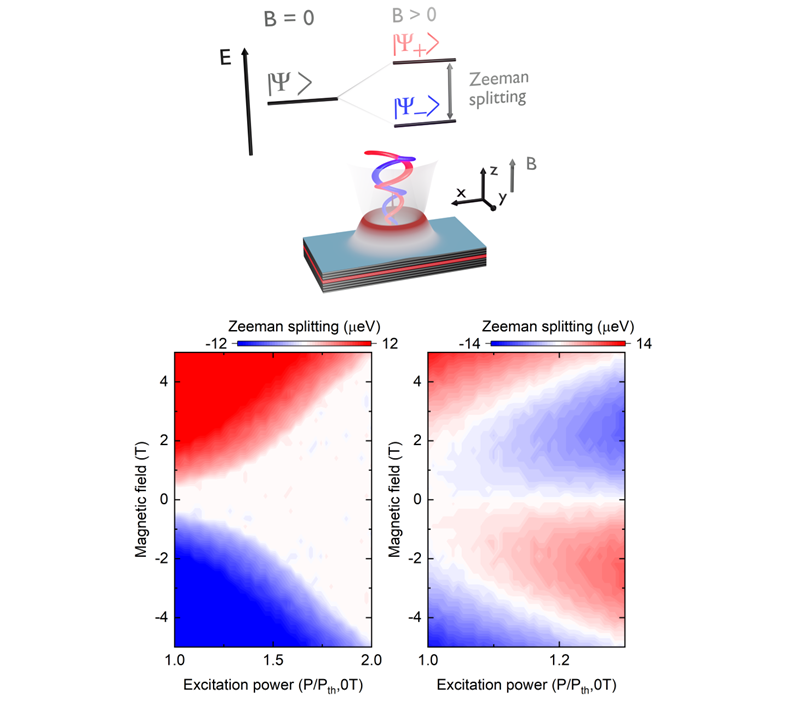
Occupancy-driven Zeeman suppression and inversion in trapped polariton condensates
K. Sawicki, D. Dovzhenko, Y. Wang, T. Cookson, H. Sigurðsson, P. G. Lagoudakis
Physical Review B 109, 125307 (2024). [Editors' suggestion]
Extremely high coherence time and, thus, ultra-narrow spectral linewidths make it possible to resolve magnetically induced µeV fine-energy shifts in trapped exciton-polariton condensates. The continuous control over the polariton confinement enabled authors to explore two operation regimes: (1) the full parametric screening of the Zeeman splitting and (2) the Zeeman inversion regime. The transition from one range to the other occurs by adjusting the size of the optical trap, which controls the strength of the polariton-polariton and polariton-exciton reservoir interactions.

Reconfigurable photon localization by coherent drive and dissipation in photonic lattices
O. Jamadi, B. Real, K. Sawicki, C. Hainaut, A. González-Tudela, N. Pernet, I. Sagnes, M. Morassi, A. Lemaître, L. Le Gratiet, A. Harouri, S. Ravets, J. Bloch, A. Amo
Optica Vol. 9, Issue 7, pp. 706-712 (2022).
Here, we show that in lattices of lossy resonators, the addition of external optical drives with a controlled phase enlarges the possibilities of manipulating interference effects and allows for the design of novel types of localized modes. Using a honeycomb lattice of coupled micropillars resonantly driven with several laser spots at energies within its photonic bands, we demonstrate the localization of light in at-will geometries down to a single site.

Polariton lasing and energy-degenerate parametric scattering in non-resonantly driven coupled planar microcavities
K. Sawicki, T. J. Sturges, M. Ściesiek, T. Kazimierczuk, K. Sobczak, A. Golnik, W. Pacuski J. Suffczyński
Nanophotonics 10(9) 2421-2429 (2021).
Here, we report non-equilibrium Bose–Einstein condensation of exciton-polaritons and low threshold, dual-wavelength polariton lasing in vertically coupled, double planar microcavities. Moreover, we find that the presence of the non-resonantly driven condensate triggers interbranch exciton-polariton transfer in the form of energy-degenerate parametric scattering.

Long-distance coupling and energy transfer between exciton states in magnetically controlled microcavities
M. Ściesiek, K. Sawicki, W. Pacuski, K. Sobczak, T. Kazimierczuk, A. Golnik, J. Suffczyński
Communications Materials 1, 78 (2020).
Here, we demonstrate polariton-mediated energy transfer between excitonic states over a distance exceeding 2 µm, thanks to confining them in semiconductor quantum wells and coupling the initial and final states of the process through the delocalized mode of two coupled optical microcavities.

Direct Interbranch Relaxation of Polaritons in a Microcavity with Embedded CdSe/(Cd,Mg)Se Quantum Wells
K. Sawicki, M. Jurczak, W. Pacuski, J. Suffczyński
Journal of Electronic Materials 49, 4531-4536 (2020).
We studied the photoluminescence excitation of a semiconductor microcavity with eight embedded CdSe/(Cd,Mg)Se quantum wells and observed a maximum in the emission from the lower polariton branch when the energy of the excitation was tuned to that of the upper polariton branch. This indicates that, in microcavities, where the upper polariton branch is hardly observable but interbranch polariton relaxation is efficient.

Triple threshold lasing from a photonic trap in a Te/Se-based optical microcavity
K. Sawicki, J.-G. Rousset, R. Rudniewski, W. Pacuski, M. Ściesiek, T. Kazimierczuk, K. Sobczak, J. Borysiuk, M. Nawrocki, J. Suffczyński
Communications Physics 2, 38 (2019).
Here, we report for a first time, all three lasing regimes and provide evidence for a three-threshold behavior in the emission from a photonic trap in a Se/Te-based planar microcavity comprising a single quantum well.






